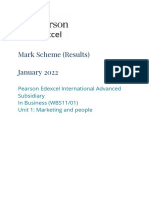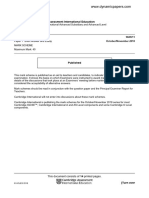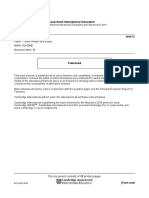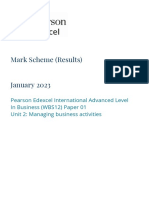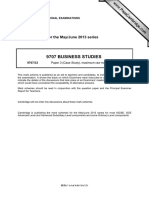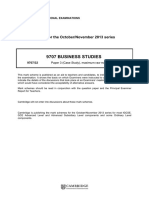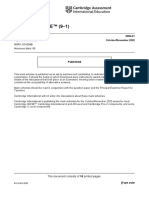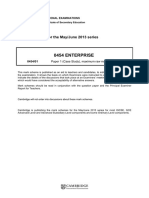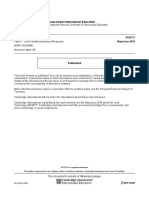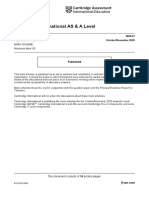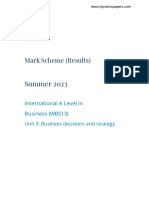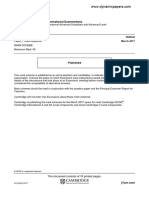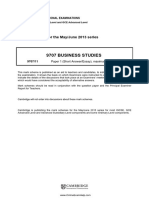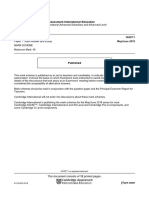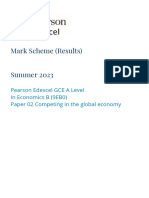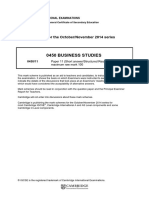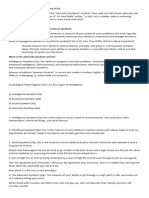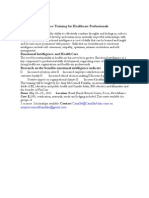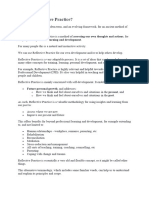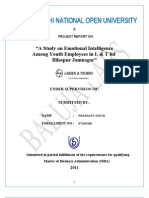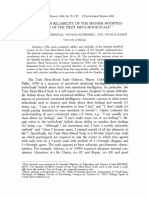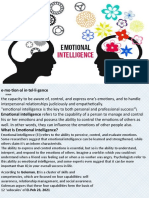Cambridge International Examinations: Business 9609/13 May/June 2017
Cambridge International Examinations: Business 9609/13 May/June 2017
Uploaded by
Nisar AhmedCopyright:
Available Formats
Cambridge International Examinations: Business 9609/13 May/June 2017
Cambridge International Examinations: Business 9609/13 May/June 2017
Uploaded by
Nisar AhmedOriginal Title
Copyright
Available Formats
Share this document
Did you find this document useful?
Is this content inappropriate?
Copyright:
Available Formats
Cambridge International Examinations: Business 9609/13 May/June 2017
Cambridge International Examinations: Business 9609/13 May/June 2017
Uploaded by
Nisar AhmedCopyright:
Available Formats
Cambridge International Examinations
Cambridge International Advanced Subsidiary and Advanced Level
BUSINESS 9609/13
Paper 1 Short Answer and Essay May/June 2017
MARK SCHEME
Maximum Mark: 40
Published
This mark scheme is published as an aid to teachers and candidates, to indicate the requirements of the
examination. It shows the basis on which Examiners were instructed to award marks. It does not indicate the
details of the discussions that took place at an Examiners’ meeting before marking began, which would have
considered the acceptability of alternative answers.
Mark schemes should be read in conjunction with the question paper and the Principal Examiner Report for
Teachers.
Cambridge will not enter into discussions about these mark schemes.
Cambridge is publishing the mark schemes for the May/June 2017 series for most Cambridge IGCSE®,
Cambridge International A and AS Level and Cambridge Pre-U components, and some Cambridge O Level
components.
® IGCSE is a registered trademark.
This document consists of 10 printed pages.
© UCLES 2017 [Turn over
9609/13 Cambridge International AS/A Level – Mark Scheme May/June 2017
PUBLISHED
Question Answer Marks
1(a) Define the term 'opportunity cost'. 2
Opportunity cost is the benefit of the next best alternative/option that is given
up/foregone/lost.
Sound definition (2 marks)
Partial definition – limited understanding (1 mark)
No creditable content (0 marks)
1(b) Briefly explain how business decisions involve opportunity cost, using 3
an appropriate example.
• Businesses have limited resources and need to make choices.
• The allocating of scarce resources between competing demands is at the
heart of most business decision making.
• A decision to invest in a particular asset/machine means that alternative
capital expenditure choices have been forgone.
• The opportunity cost of paying a generous dividend to shareholders is the
lost opportunity to better reward employees.
• Businesses become very competitive to reduce the strength of the next
best alternative.
Sound explanation of a business decision involving opportunity cost with an
example. (3 marks)
Limited explanation of a business decision involving opportunity cost with an
example. (2 marks)
Some understanding of business decisions and opportunity cost. (1 mark)
No creditable content (0 marks)
© UCLES 2017 Page 2 of 10
9609/13 Cambridge International AS/A Level – Mark Scheme May/June 2017
PUBLISHED
Question Answer Marks
2(a) Define the term 'buffer inventory’. 2
The minimum/safety inventory level that should be held to ensure that
production can take place should delivery of supplies be delayed / or
production rates need to increase.
Sound definition (2 marks)
Partial definition (limited understanding) (1 mark)
No creditable content (0 marks)
2(b) Briefly explain two likely consequences for a business of poor inventory 3
management.
Answers could include:
Inventory is raw materials, work in progress, finished products.
Consequences of inefficient inventory management could include:
• Cost implications – storage costs, inventory handling costs,
damaged/obsolescence, opportunity costs of capital tied up in stock (too
high inventory levels).
• Insufficient inventories to meet changes in demand – lost sales.
• Out-of-date inventories – non-rotation – leads to losses – food – fast
changing technology products.
• Late deliveries
• Low discounts from suppliers
• Idle production – resources if inventory supplies run out.
• Excess finished goods – may need to reduce prices.
Sound explanation of two consequences of poor inventory management
(3 marks)
Sound explanation of one consequence or partial explanation of two
consequences (2 marks)
Partial explanation of one consequence or a list of two (1 mark)
No creditable content (0 marks)
© UCLES 2017 Page 3 of 10
9609/13 Cambridge International AS/A Level – Mark Scheme May/June 2017
PUBLISHED
Question Answer Marks
3 Explain how viral marketing could be an important part of marketing for a 5
business.
Answers may include:
• Definition of viral marketing – marketing technique that uses social media
networks to increase brand awareness of products and services. Idea is to
generate an 'infection' of thought among the base users which is passed
on and multiplied.
• Viral marketing adds to the traditional methods of marketing the messages
of a business.
• Viral marketing can build brand recognition very quickly.
• Viral marketing may well be a highly effective and cost efficient tool in the
marketing mix in exploiting social networks to produce exponential
increases in brand awareness.
• Viral marketing becomes very attractive as traditional channels become
more competitive and expensive.
• Very attractive to start-up ventures with limited marketing budgets and can
deliver outstanding results in a short space of time.
• Viral marketing needs to be integrated with the other variables in a
marketing mix, and can significantly improve a marketing ROI.
• So viral marketing can be an important part of a marketing strategy, but
there are risks.
Effective explanation of how viral marketing could be an important part of
marketing for a business. (4–5 marks)
Limited explanation of how viral marketing could be an important part
marketing for a business. (2–3 marks)
Understanding of viral marketing / marketing (1 mark)
No creditable content (0 marks)
© UCLES 2017 Page 4 of 10
9609/13 Cambridge International AS/A Level – Mark Scheme May/June 2017
PUBLISHED
Question Answer Marks
4(a) Define the term 'share capital'. 2
Share capital is the total value of capital/finance raised from shareholders
through the issue of shares or capital used by shareholders to buy shares in a
plc.
Sound definition (2 marks)
Partial definition (limited understanding) (1 mark)
No creditable content (0 marks)
4(b) Briefly explain one advantage and one disadvantage of grants as a 3
source of business finance.
Answers could include:
A definition/description of grants
Funding for businesses often provided by grant giving agencies such as a
central government. These are often given to small businesses or those
wanting to expand in developing regions.
They are often given with conditions attached such as a target number of jobs
to be created – if such conditions are met, such grants do not have to be
repaid.
Advantages:
• free money-an attractive financial consideration
• good for businesses unable to afford or get a loan
• gives confidence to banks and investors
• important complement to existing funds
• validates the efficacy of your business
• easier to get more grants once awarded one
Disadvantages:
• may be difficult to get
• eligibility criteria too demanding
• may be too small/insufficient for needs, matching funds
• may have too stringent conditions attached
• may be too much red tape involved/slow
• too much detailed information required
• too much detailed control and monitoring of grant use
• may become too reliant on grant funding
• may be used unwisely
Sound explanation of one advantage and one disadvantage of grants for
business finance. (3 marks)
Limited explanation of one advantage and one disadvantage of grants for
business finance or a sound explanation of either. (2 marks)
Understanding of grants. (1 mark)
No creditable content (0 marks)
© UCLES 2017 Page 5 of 10
9609/13 Cambridge International AS/A Level – Mark Scheme May/June 2017
PUBLISHED
Question Answer Marks
5(a) Analyse how the features of an international market may differ from the 8
features of a national market.
Level Description Marks
Good analysis of how the features of international
4 7–8
markets may differ from those of national markets.
Some analysis of how the features of international
3 5–6
markets may differ from those of national markets.
Some explanation of the features of international/
2 3–4
national markets.
Limited understanding of international / national
1 1–2
markets.
0 No creditable content 0
Answers may include:
Selling in foreign markets is much more common in the 21st century –
globalisation.
International markets are an opportunity to profitably expand sales – indeed,
competition may require it.
What are the special features/problems likely to exist in international markets
not experienced in national/regional markets –
• legal differences – different/lack of regulations
• unstable governments – leading to acts of terrorism, civil violence
• differences in tax rates – living standards – age profile etc.
• cultural differences – role of women may be different – use of language –
dress codes – different products demanded.
• business practices – different legal practices – working conditions, use of
'gifts' to obtain contracts.
• more uncertainty – more complex environment socially, economically and
politically in an international market.
• possibility of cheaper labour and materials
• larger markets/more segmented markets
There may be common features that present no particular challenge but
international markets may present distinctive challenges to the marketing
approach of a business.
© UCLES 2017 Page 6 of 10
9609/13 Cambridge International AS/A Level – Mark Scheme May/June 2017
PUBLISHED
Question Answer Marks
5(b) Discuss the advantages and limitations for a multi-product business of 12
using product life cycles to help make effective marketing decisions.
Level Description Marks
Effective evaluation of advantages and limitations of
4 9–12
product life cycles for a multi-product business.
Limited evaluation of advantages and limitations of
3 7–8
product life cycles for a multi-product business.
Analysis and some application of advantages and/or
2 3–6
limitations of product life cycles for a business.
Understanding of product life cycles / marketing
1 1–2
decisions.
0 No creditable content 0
Answers may include:
• Explain the PLC concept – the life cycle of a product/service – record and
analyse the sales of a product from launch to withdrawal from the market.
• A main form of product portfolio analysis – important in the context of this
multi-product business.
Advantages
• Helps a business develop a balanced portfolio of products – with products
at different stages of life cycle.
• Helps a business to plan ahead with new products – take out old ones –
identify gaps – determine type of marketing required for each product.
• Provides information for the use of the marketing mix – e.g. penetration
pricing in early stage of a product – high promotional expenditure in growth
period – extension strategies later.
Limitations
• Exact span of a life cycle for a product is often difficult to estimate.
• External changes in the market (new technology) can quickly reduce the
value of planning based on life-cycle forecasts.
• Extension strategies may or may not reverse the decline of a product.
• Many products do not go through a complete life cycle.
• PLC not so useful in dynamic, ever-changing markets.
• It may be expensive to do in a multi-product business
Evaluation might discuss whether the product life cycle approach is sufficient to
make effective marketing decisions; is more needed e.g. more focussed
attention on marketing issues?
© UCLES 2017 Page 7 of 10
9609/13 Cambridge International AS/A Level – Mark Scheme May/June 2017
PUBLISHED
Question Answer Marks
6 'Senior business managers must have a high level of emotional 20
intelligence to be effective'.
Do you agree with this view? Justify your answer.
Level Description Marks
Effective evaluation of the statement that senior
5 managers must have a high level of emotional 17–20
intelligence to be effective.
Good analysis and limited evaluation of the statement
4 that senior managers must have a high level of 13–16
emotional intelligence to be effective.
Analysis of the statement that senior managers must
3 have a high level of emotional intelligence to be 11–12
effective.
Limited analysis of emotional intelligence with possibly
2 5–10
some application to senior managers.
Understanding of emotional intelligence / senior
1 1–4
managers.
0 No creditable content 0
Answers may include:
• The context is senior managers – likely to be managing significant
resources, making important decisions – needing to galvanise staff to
achieve organisational objectives.
• The statement is that, as well as an appropriate level of intellectual
intelligence (IQ), effective managers should have and develop an
appropriate level of emotional intelligence (EI). This is the theory of
multiple intelligences and emotional intelligence is said to be the ability to
understand and manage your own emotions and those of the people you
work with and manage, and so achieve better business performance.
• Goleman developed the notion of emotional intelligence competencies:
self-awareness, self-management, social awareness, and social skills.
With these, managers are more likely to have self-confidence, a more
realistic awareness of employee characteristics and needs, recover more
quickly from stress, manage stress better, develop self-control, become
more sensitive and empathetic, negotiate and lead with a more emotionally
stable behaviour. The idea that 'soft is hard' for the practice of effective
management.
• Consider the tasks and situations a senior business manager needs to
manage and the value of a measure of emotional intelligence may seem
obvious.
• Are some more traditional attributes/characteristics of managers more
important than emotional intelligence, e.g. resoluteness, determination – in
the short-term aggressive 'bullying' managers can be very effective – and
not all employees want 'soft' managers. Look for evaluative comment.
• Credit answers that link EI with anti Taylor views and support motivational
theorists who focus on issues like Emotional Intelligence.
© UCLES 2017 Page 8 of 10
9609/13 Cambridge International AS/A Level – Mark Scheme May/June 2017
PUBLISHED
Question Answer Marks
7(a) Analyse the rights and responsibilities of employees as stakeholders in a 8
business.
Level Description Marks
Good analysis of the rights and responsibilities of
4 7–8
employees as stakeholders in a business.
Some analysis of the rights and responsibilities of
3 5–6
employees as stakeholders in a business.
Some explanation of the rights and/or responsibilities
2 3–4
of employees as stakeholders in a business.
1 Limited understanding of employees or stakeholders. 1–2
0 No creditable content 0
Answers may include:
As stakeholders in a business, employees are said to have certain rights:
• to be given legal entitlements – minimum wage etc.
• to be treated in the workplace as set out in an employment contract –
conditions of service, hours, disciplinary procedures, holiday entitlements.
• to join a union or trade association to protect employment rights.
• to have basic human rights guaranteed.
As stakeholders, employees are also said to have responsibilities:
• to meet the conditions of the contract of employment.
• to be honest and productive.
• to co-operate with managers and supervisors.
• to uphold the ethical codes of behaviour set by a business.
• to respect the confidentiality of the business.
© UCLES 2017 Page 9 of 10
9609/13 Cambridge International AS/A Level – Mark Scheme May/June 2017
PUBLISHED
Question Answer Marks
7(b) Discuss how the stakeholders of a public sector organisation might be 12
affected by a reduction in Government financial support for the
organisation.
Level Description Marks
Effective evaluation of how stakeholders might be
4 affected by a reduction in Governmental financial 9–12
support for a public sector organisation.
Limited evaluation of how stakeholders might be
3 affected by a reduction in Governmental financial 7–8
support for a public sector organisation.
Analysis and some application of how stakeholders
2 might be affected by a reduction in Governmental 3–6
financial support for an organisation.
Understanding of stakeholders/ public sector
1 1–2
organisations / Government financial support.
0 No creditable content. 0
Answers could include:
Comment on the characteristic features of a public sector organisation.
Speculation on the degree of importance of the service(s) provided by this
public sector organisation (presumably not a vital service, or a service that
could be provided with less governmental financial support.)
Stakeholders affected by such a scenario could include
• Customers/service users may be concerned that services may no longer
be available, or reduced, or subject to price increase if a different form of
service provision resulted such as private sector provision.
• Employees may be concerned about potential job losses if the
organisation contracts and reduced conditions of employment if drastic
measures are taken to preserve a reduced service.
• Unions will be concerned about potential impact on their members.
• Local Government affected by the threat to this public sector organisation
will be concerned for their local economies.
• Suppliers to this public sector organisation will have concerns of the
impact of the reduction in governmental financial support on their
businesses.
Good answers will recognise that the impact on stakeholders will very much
depend on the extent of the reduction in financial support, on the discretion
available to the public sector organisation to make savings, gain alternative
sources of finance, and/or or make changes to the structure/systems, and/or
management of the organisation.
Some stakeholders may suffer (employees) but others may benefit as the
Government spends less e.g. lower tax rates for tax payers and more
discretionary options for government.
© UCLES 2017 Page 10 of 10
You might also like
- Emotional Quotient Inventory: Youth Version (EQ-i:YV) By: Reuven Bar-On, Ph.D. & James D.A. Parker, PH.DDocument2 pagesEmotional Quotient Inventory: Youth Version (EQ-i:YV) By: Reuven Bar-On, Ph.D. & James D.A. Parker, PH.DJelene0% (2)
- Building Blocks of Emotional IntelligenceDocument19 pagesBuilding Blocks of Emotional Intelligenceผศ.ดร.ทวิพันธ์ พัวสรรเสริญ100% (2)
- WBS11:01 Jan 2022 MSDocument17 pagesWBS11:01 Jan 2022 MSabdulrahmanNo ratings yet
- WBS11 MS EamsDocument14 pagesWBS11 MS EamsFatema Waleed Mohammed Alnaw Alhebsi100% (1)
- Paper-2-Oct-2019-Marking SchemeDocument17 pagesPaper-2-Oct-2019-Marking SchemeshamimahNo ratings yet
- You, Inc.: Burke HedgesDocument43 pagesYou, Inc.: Burke Hedgeskinglolo100% (1)
- Cambridge Assessment International Education: Business 9609/11 October/November 2017Document10 pagesCambridge Assessment International Education: Business 9609/11 October/November 2017RuslanNo ratings yet
- Cambridge International Examinations: Business Studies 0450/22 March 2017Document12 pagesCambridge International Examinations: Business Studies 0450/22 March 2017Wambui KahendeNo ratings yet
- 9609 s19 Ms 12Document12 pages9609 s19 Ms 12Hashir Naveed MirzaNo ratings yet
- 9609 MW ScriptAC P1 MSDocument14 pages9609 MW ScriptAC P1 MS章琳雯No ratings yet
- 9609 w16 Ms 11Document8 pages9609 w16 Ms 11Mohammed NaimNo ratings yet
- Cambridge Assessment International Education: Business 9609/11 October/November 2019Document15 pagesCambridge Assessment International Education: Business 9609/11 October/November 2019skaugfdgvwafNo ratings yet
- Case A Marking RubricDocument4 pagesCase A Marking RubricKrrishna Rajesh TOKARAWATNo ratings yet
- Cambridge Assessment International Education: Business 9609/23 May/June 2018Document11 pagesCambridge Assessment International Education: Business 9609/23 May/June 2018LightNo ratings yet
- June 2016 Paper 3 Mark Scheme 9609Document12 pagesJune 2016 Paper 3 Mark Scheme 9609Lejla Eminovic Niksic0% (1)
- 9609 m17 Ms 22Document11 pages9609 m17 Ms 22kazamNo ratings yet
- Cambridge Assessment International Education: Business 9609/11 October/November 2018Document14 pagesCambridge Assessment International Education: Business 9609/11 October/November 2018RuslanNo ratings yet
- Cambridge Assessment International Education: Business 9609/13 May/June 2019Document12 pagesCambridge Assessment International Education: Business 9609/13 May/June 2019AbdulBasitBilalSheikhNo ratings yet
- Maximum Mark: 60: Cambridge International Advanced Subsidiary and Advanced LevelDocument8 pagesMaximum Mark: 60: Cambridge International Advanced Subsidiary and Advanced Leveltafadzwa tandawaNo ratings yet
- 9609 MW ScriptB P1 MSDocument12 pages9609 MW ScriptB P1 MS章琳雯No ratings yet
- As Business Mark Schemes 2020 - CompressedDocument826 pagesAs Business Mark Schemes 2020 - CompressedjeandreNo ratings yet
- Answer For As Level Past PaperDocument14 pagesAnswer For As Level Past PaperReddy Girinath100% (1)
- Cambridge Assessment International Education: Business 9609/11 October/November 2018Document14 pagesCambridge Assessment International Education: Business 9609/11 October/November 2018Low JeNo ratings yet
- Cambridge International Examinations: Business 9609/12 May/June 2017Document11 pagesCambridge International Examinations: Business 9609/12 May/June 2017AbdulBasitBilalSheikhNo ratings yet
- Cambridge Assessment International Education: Business 9609/31 May/June 2019Document16 pagesCambridge Assessment International Education: Business 9609/31 May/June 2019Find tutorNo ratings yet
- Cambridge International AS & A Level: Business 9609/12 October/November 2020Document15 pagesCambridge International AS & A Level: Business 9609/12 October/November 2020Jawad NadeemNo ratings yet
- 0450_s19_ms_22Document14 pages0450_s19_ms_22Maliha NuzhatNo ratings yet
- wbs12 01 Rms 20230302Document19 pageswbs12 01 Rms 20230302Brendon NoronhaNo ratings yet
- Cambridge Assessment International Education: Business 9609/12 October/November 2018Document14 pagesCambridge Assessment International Education: Business 9609/12 October/November 2018Low JeNo ratings yet
- Cambridge International AS & A Level: Business 9609/11 May/June 2020Document14 pagesCambridge International AS & A Level: Business 9609/11 May/June 2020VinayakNo ratings yet
- Cambridge International Examinations Cambridge International Advanced Subsidiary and Advanced LevelDocument9 pagesCambridge International Examinations Cambridge International Advanced Subsidiary and Advanced LevelNathania PriscillaNo ratings yet
- 9609 s16 Ms 12Document10 pages9609 s16 Ms 12Sathya ViswanathanNo ratings yet
- 0450 Business Studies: MARK SCHEME For The October/November 2006 Question PaperDocument5 pages0450 Business Studies: MARK SCHEME For The October/November 2006 Question PaperhjsalrayesNo ratings yet
- 9707 Business Studies: MARK SCHEME For The May/June 2013 SeriesDocument8 pages9707 Business Studies: MARK SCHEME For The May/June 2013 Series8jnmvbvqvwNo ratings yet
- Cambridge International Examinations: Business 9609/21 May/June 2017Document17 pagesCambridge International Examinations: Business 9609/21 May/June 2017abhiru halgamaNo ratings yet
- Mark Scheme (Results) June 2008: GCSE Business Studies (1503.02)Document10 pagesMark Scheme (Results) June 2008: GCSE Business Studies (1503.02)Nipuni PereraNo ratings yet
- 9609 m16 Ms 12 PDFDocument9 pages9609 m16 Ms 12 PDFViviana CorneteanuNo ratings yet
- 9707 Business Studies: MARK SCHEME For The October/November 2013 SeriesDocument9 pages9707 Business Studies: MARK SCHEME For The October/November 2013 SeriesAHMADNo ratings yet
- Individual Assignment DCV150321Document6 pagesIndividual Assignment DCV150321Jalna IsaacNo ratings yet
- November 2020 Mark Scheme Paper 21Document16 pagesNovember 2020 Mark Scheme Paper 21Edwin OdwesoNo ratings yet
- Cambridge International AS & A Level: Business 9609/22 March 2020Document15 pagesCambridge International AS & A Level: Business 9609/22 March 2020Ayush OjhaNo ratings yet
- Cambridge International AS & A Level: Business 9609/23 May/June 2020Document11 pagesCambridge International AS & A Level: Business 9609/23 May/June 2020VinayakNo ratings yet
- Cambridge IGCSE™: Business Studies 0450/13 October/November 2020Document20 pagesCambridge IGCSE™: Business Studies 0450/13 October/November 2020Wilfred BryanNo ratings yet
- Mark Schdeme - 13Document15 pagesMark Schdeme - 13bmensahgms2No ratings yet
- Cambridge O Level: Business Studies 7115/22 October/November 2020Document15 pagesCambridge O Level: Business Studies 7115/22 October/November 2020r3za_5008No ratings yet
- Cambridge IGCSE™: Business Studies 0450/22 March 2020Document15 pagesCambridge IGCSE™: Business Studies 0450/22 March 2020Aryan AgarwalNo ratings yet
- 0454 Enterprise: MARK SCHEME For The May/June 2013 SeriesDocument9 pages0454 Enterprise: MARK SCHEME For The May/June 2013 Serieseshwartunga767No ratings yet
- 9609_s18_ms_33Document14 pages9609_s18_ms_33Amit GuptaNo ratings yet
- Cambridge International Advanced Subsidiary and Advanced LevelDocument9 pagesCambridge International Advanced Subsidiary and Advanced LevelShrikhaNo ratings yet
- MOCK - Paper 2 - 0450 - w17 - Ms - 21Document12 pagesMOCK - Paper 2 - 0450 - w17 - Ms - 21Sasa DzudzevicNo ratings yet
- Cambridge Assessment International Education: Business Studies 0450/13 May/June 2018Document16 pagesCambridge Assessment International Education: Business Studies 0450/13 May/June 2018Ayesha JagotNo ratings yet
- wbs13-01 - Business Marck SchemeDocument16 pageswbs13-01 - Business Marck SchemeDumongNo ratings yet
- Cambridge International AS & A Level: Business 9609/23 October/November 2020Document16 pagesCambridge International AS & A Level: Business 9609/23 October/November 2020Kwadwo AsareNo ratings yet
- wbs13 01 Rms 20230817Document13 pageswbs13 01 Rms 20230817DumongNo ratings yet
- Cambridge International AS & A Level: Business 9609/23 May/June 2020Document11 pagesCambridge International AS & A Level: Business 9609/23 May/June 2020Rinnah TeklayNo ratings yet
- Cambridge International Examinations: Business 9609/22 March 2017Document11 pagesCambridge International Examinations: Business 9609/22 March 2017RuslanNo ratings yet
- 9707 s13 Ms 11Document6 pages9707 s13 Ms 11lexyaNo ratings yet
- Cambridge O Level: Business Studies 7115/21 October/November 2020Document16 pagesCambridge O Level: Business Studies 7115/21 October/November 2020r3za_5008No ratings yet
- Cambridge IGCSE™: Business Studies 0450/11 May/June 2020Document10 pagesCambridge IGCSE™: Business Studies 0450/11 May/June 2020Daniel NAMNo ratings yet
- Cambridge Assessment International Education: Business 9609/11 May/June 2018Document12 pagesCambridge Assessment International Education: Business 9609/11 May/June 2018Dhrisha GadaNo ratings yet
- 9EB0 02 Rms 20230817Document21 pages9EB0 02 Rms 20230817dylsinghbNo ratings yet
- 0450 Business Studies: MARK SCHEME For The October/November 2014 SeriesDocument23 pages0450 Business Studies: MARK SCHEME For The October/November 2014 SeriesSara ShaikhNo ratings yet
- DeepTech Playbook: How to Master the Complexity of DeepTech VenturesFrom EverandDeepTech Playbook: How to Master the Complexity of DeepTech VenturesNo ratings yet
- Assessing Leadership Styles and Organisational Context Dulewicz and HiggsDocument19 pagesAssessing Leadership Styles and Organisational Context Dulewicz and HiggsHaithem Darwich0% (1)
- 28 Đề thi thử TN THPT Tiếng Anh 2024 - THPT HÀ TRUNG - TH - kj09fBuFEpDocument15 pages28 Đề thi thử TN THPT Tiếng Anh 2024 - THPT HÀ TRUNG - TH - kj09fBuFEpRoyJJNo ratings yet
- Adversity Quotient and Its Difference To IQDocument2 pagesAdversity Quotient and Its Difference To IQangelaaamariipNo ratings yet
- Level 1 Certification: Emotional Intelligence Training For Healthcare ProfessionalsDocument1 pageLevel 1 Certification: Emotional Intelligence Training For Healthcare Professionalsdmarkee4No ratings yet
- What Is Reflective PracticeDocument29 pagesWhat Is Reflective PracticedeangimsrNo ratings yet
- 1.1 Background of The StudyDocument62 pages1.1 Background of The StudyWahidin Alamnuari RachmanNo ratings yet
- Business Communication Chap01Document13 pagesBusiness Communication Chap01shabbirmia570No ratings yet
- What Significant Contribution Can You Recall About This Person?Document4 pagesWhat Significant Contribution Can You Recall About This Person?Maribel Quiocson100% (2)
- HR ProjectDocument101 pagesHR ProjectVinod Sharma Vashishth67% (3)
- Ahmed Indivitual ReportDocument11 pagesAhmed Indivitual ReportsamNo ratings yet
- Neubauer Freudenthaler 2005 ModelsofEIDocument12 pagesNeubauer Freudenthaler 2005 ModelsofEIZuemy BatunNo ratings yet
- Andrew J. DuBrin - Human Relations - Interpersonal Job-Oriented Skills-Pearson (2014)Document465 pagesAndrew J. DuBrin - Human Relations - Interpersonal Job-Oriented Skills-Pearson (2014)Dragon SlayerNo ratings yet
- Week 3 - Emotinal ItelligenceDocument22 pagesWeek 3 - Emotinal Itelligencemuhammad langgawanputraNo ratings yet
- 7HR528 AssessmentDocument19 pages7HR528 Assessmentlynneunlocks100% (1)
- Text Why Is Emotional Intelligence Important For TeensDocument2 pagesText Why Is Emotional Intelligence Important For Teensno nameNo ratings yet
- TMMS EspañolDocument5 pagesTMMS EspañolJoséNo ratings yet
- PDDocument47 pagesPDshanu priNo ratings yet
- Toxic LeadershipDocument6 pagesToxic LeadershipArthur Barie100% (1)
- Leadership Philosophy Paper FinalDocument17 pagesLeadership Philosophy Paper Finalapi-506482100No ratings yet
- Organizational BehaviorDocument35 pagesOrganizational BehaviorNa Lisa LeeNo ratings yet
- Emotional Intelligence - 2 Books in 1 - Emotional Intelligence EQ & How To Analyze PeopleDocument287 pagesEmotional Intelligence - 2 Books in 1 - Emotional Intelligence EQ & How To Analyze PeopleHéctor GonzálezNo ratings yet
- DMIT Sample ReportDocument33 pagesDMIT Sample ReportgkreddiNo ratings yet
- Johari Explain Chapman 2003Document28 pagesJohari Explain Chapman 2003kinnarieNo ratings yet
- General Well-Being of Higher Secondary Students: Research PapersDocument8 pagesGeneral Well-Being of Higher Secondary Students: Research Papersymir shoyoNo ratings yet
- Profiling Industry-Relevant Management Graduate Competencies: The Need For A Fresh ApproachDocument14 pagesProfiling Industry-Relevant Management Graduate Competencies: The Need For A Fresh ApproachEzlina AhnuarNo ratings yet
- Competency MappingDocument28 pagesCompetency MappingSujata Mansukhani100% (2)
- (TNLĐ 2023) Aptitude Test 1 ENGDocument9 pages(TNLĐ 2023) Aptitude Test 1 ENGThalia NguyenNo ratings yet


